Experimental Study on Performance of Modified Cement-Based Building Materials under High-Water-Pressure Surrounding Rock Environment
Abstract
1. Introduction
2. Basic Performance Study of Single Cement Slurry
2.1. Test Materials and Procedure
2.2. Analysis of Experimental Results
3. Basic Performance Study of Cement–Polyvinyl Alcohol–Boric Acid Slurry
3.1. Effect of Polyvinyl Alcohol Concentration on Gelation Time
3.2. Effect of Boric Acid on Cement–Polyvinyl Alcohol Slurry Properties
3.3. Effect of Polyvinyl Alcohol Concentration on Stone Formation Ratio
3.4. Cement–Polyvinyl Alcohol Slurry’s Moving Water Retention Ratio
3.5. Scanning Electron Microscope Analysis
4. Project Application
5. Discussion
6. Conclusions
Author Contributions
Funding
Institutional Review Board Statement
Informed Consent Statement
Data Availability Statement
Acknowledgments
Conflicts of Interest
References
- Assaad, J.J.; Gerges, N. Styrene-butadiene rubber modified cementitious grouts for embedding anchors in humid environments. Tunn. Undergr. Space Technol. 2018, 84, 317–325. [Google Scholar] [CrossRef]
- Han, X.L.; Chen, X.M.; Jiao, H.Z.; Sun, G.D.; Dong, T.F. Research status and prospect of polymer-cement grouting materials. Bull. Chin. Ceram. Soc. 2018, 37, 2457–2462. [Google Scholar] [CrossRef]
- Corson, L.; Reid, C.; Lunn, R.J.; El Mountassir, G.; Henderson, A.E.; Henderson, K.; Pagano, A.G.; Kremer, Y. Field validation of a detectable, magnetic, cementitious grout for rock fracture grouting. Int. J. Rock Mech. Min. Sci. 2021, 145, 104853. [Google Scholar] [CrossRef]
- De la Varga, I.; Spragg, R.P.; Muñoz, J.F.; Helsel, M.A.; Graybeal, B.A. Cracking, bond, and durability performance of internally cured cementitious grouts for prefabricated bridge element connections. Sustainability 2018, 10, 3881. [Google Scholar] [CrossRef]
- Li, X.; Cao, L.; Zhao, X. Assessment of potential impact of tunneling on the groundwater in Epi-Fissure-Karst-Zone and ecological environment. Environ. Earth Sci. 2011, 66, 967–976. [Google Scholar] [CrossRef]
- Xie, X.-C.; Ceccato, F.; Zhou, M.-L.; Zhang, D.-M. Hydro-mechanical behaviour of soils during water-soil gushing in shield tunnels using MPM. Comput. Geotech. 2022, 145, 104688. [Google Scholar] [CrossRef]
- Hua, X.Z.; Xie, G.X. Research on grouting material for bolt and grouting reinforcement of soft rock tunnel and its application. Rock Soil Mech. 2004, 25, 1462–1646. [Google Scholar]
- Zhang, X.D. Study of Material for Curtain Grouting in Karst Tunnel. Undergr. Space Eng. 2005, 3, 432–434. [Google Scholar]
- Tian, K.; Ding, Q.J.; Chen, Y.Q.; Luo, J. Optimal design of high volume fly ash simultaneous grouting material for shield tunnel. Tunnel Constr. 2007, 27, 26–29. [Google Scholar]
- Xiao, L.; Zhang, Q.H.; Zhao, T.S.; Yang, J.L.; Yang, G.H. Study on mortar material of tail void grouting in slurry shield tunnel. Chin. J. Undergr. Space Eng. 2011, 7, 59–64. [Google Scholar] [CrossRef]
- Liu, P.; Yan, C.; Sun, G.; Xi, L.; Liu, J. Experimental study on performance of grouting material for repairing surrounding rock in river intake tunne. Geotech. Investig. Surv. 2016, 44, 11–15+44. [Google Scholar]
- Zhang, C.; Fu, J.; Yang, J.; Ou, X.; Ye, X.; Zhang, Y. Formulation and performance of grouting materials for underwater shield tunnel construction in karst ground. Constr. Build. Mater. 2018, 187, 327–338. [Google Scholar] [CrossRef]
- Zhang, C.; Yang, J.; Fu, J.; Ou, X.; Xie, Y.; Liang, X. Performance evaluation of modified cement-sodium silicate grouting material for prereinforcing loose deposit tunnels. J. Mater. Civ. Eng. 2019, 31, 06019003. [Google Scholar] [CrossRef]
- Zhang, W.; Zhu, X.; Xu, S.; Wang, Z.; Li, W. Experimental study on properties of a new type of grouting material for the reinforcement of fractured seam floor. J. Mater. Res. Technol. 2019, 8, 5271–5282. [Google Scholar] [CrossRef]
- Liu, Y.; Chen, B. Research on the preparation and properties of a novel grouting material based on magnesium phosphate cement. Constr. Build. Mater. 2019, 214, 516–526. [Google Scholar] [CrossRef]
- Wan, Y.; Zhu, Z.; Song, L.; Song, S.; Zhang, J.; Gu, X.; Xu, X. Study on temporary filling material of synchronous grouting in the middle of shield. Constr. Build. Mater. 2020, 273, 121681. [Google Scholar] [CrossRef]
- Wang, J.; Dai, Q.; Si, R.; Guo, S. Investigation of properties and performances of Polyvinyl Alcohol (PVA) fiber-reinforced rubber concrete. Constr. Build. Mater. 2018, 193, 631–642. [Google Scholar] [CrossRef]
- Zhang, J.; Guan, X.; Li, H.; Liu, X. Performance and hydration study of ultra-fine sulfoaluminate cement-based double liquid grouting material. Constr. Build. Mater. 2017, 132, 262–270. [Google Scholar] [CrossRef]
- Sun, Y.; Zhang, P.; Yan, W.; Wu, J.; Yan, F. Grouting Material Development and Dynamic Grouting Test of Broken Rock Mass. J. Mater. Civ. Eng. 2022, 34, 04022072. [Google Scholar] [CrossRef]
- Liu, B.; Yin, L.; Chen, J.; Li, M.; Tang, D.; Zhang, Y. Experimental study on the influence of PVA content on the performance of grouting material in deep stope. Geofluids 2021, 2021, 6684754. [Google Scholar] [CrossRef]
- Lu, Y.; Li, C.; Zhang, X.; Huang, X.; Zhao, Z. A Workability Characterization of Innovative Rubber Concrete as a Grouting Material. Materials 2022, 15, 5319. [Google Scholar] [CrossRef] [PubMed]
- Yang, Q.; Geng, P.; Wang, J.; Chen, P.; He, C. Research of asphalt–cement materials used for shield tunnel backfill grouting and effect on anti-seismic performance of tunnels. Constr. Build. Mater. 2021, 318, 125866. [Google Scholar] [CrossRef]
- Le, H.; Sun, S. Effect of grouting materials and inclination angle of preexisting flaw on uniaxial compressive strength and failure mode of rock-like specimens. Rock Soil Mech. 2018, 39, 211–219. [Google Scholar] [CrossRef]
- Ma, S.; Ma, D. Grouting Material for broken surrounding rock and its mechanical properties of grouting reinforcement. Geotech. Geol. Eng. 2021, 39, 3785–3793. [Google Scholar] [CrossRef]
- Le, H.; Sun, S.; Wei, J. Influence of Types of Grouting Materials on Compressive Strength and Crack Behavior of Rocklike Specimens with Single Grout-Infilled Flaw under Axial Loads. J. Mater. Civ. Eng. 2019, 31, 06018022. [Google Scholar] [CrossRef]
- Zhu, C.; Zhang, J.; Peng, J.; Cao, W.; Liu, J. Physical and mechanical properties of gypsum-based composites reinforced with PVA and PP fibers. Constr. Build. Mater. 2018, 163, 695–705. [Google Scholar] [CrossRef]
- Zhang, B.; Gao, F.; Zhang, X.; Zhou, Y.; Hu, B.; Song, H. Modified cement-sodium silicate material and grouting technology for repairing underground concrete structure cracks. Arab. J. Geosci. 2019, 12, 680. [Google Scholar] [CrossRef]
- Duque-Ossa, L.; Ruiz-Pulido, G.; Medina, D. Triborheological study under physiological conditions of PVA hydrogel/HA lubricant as synthetic system for soft tissue replacement. Polymers 2021, 13, 746. [Google Scholar] [CrossRef]
- Yuan, Z.; Zhang, C.; Xia, C.; Wu, L.; Yu, Z.; Li, Z. Flexural properties of PVA fiber reinforced high ductility cementitious composites containing calcium carbonate whisker. Constr. Build. Mater. 2021, 300, 124329. [Google Scholar] [CrossRef]
- Jiang, H.; Qiu, X. Performance assessment of a newly developed and highly stable grouting material for a completely weathered granite dam foundation. Constr. Build. Mater. 2021, 299, 123956. [Google Scholar] [CrossRef]
- Pei, J.; Cai, J.; Zou, D.; Zhang, J.; Li, R.; Chen, X.; Jin, L. Design and performance validation of high-performance cement paste as a grouting material for semi-flexible pavement. Constr. Build. Mater. 2016, 126, 206–217. [Google Scholar] [CrossRef]
- Zhang, P.; Su, Y.-L.; Fan, J.-J.; Feng, H.; Shao, J.; Guo, H.; Gao, D.-Y.; Sheikh, S.A. Experimental research on the mechanical behavior of grouted sleeves with fiber-reinforced grouting material under cyclic loading. Structures 2021, 34, 2189–2204. [Google Scholar] [CrossRef]
- Xiao, C.; Zhang, Y. Structural investigation of poly(vinyl alcohol) fibers under axial compressional deformation. Acta Polym. Sin. 2002, 18, 791–794. [Google Scholar] [CrossRef]
- Li, J.-F.; Liu, Y.-T.; Li, S.-J.; Song, Y. Experimental investigation of synchronous grouting material prepared with different mineral admixtures. Materials 2022, 15, 1260. [Google Scholar] [CrossRef]
- Liu, D.; Xu, Q.; Tang, Y.; Jian, Y. Prediction of water inrush in long-lasting shutdown karst tunnels based on the HGWO-SVR model. IEEE Access 2020, 9, 6368–6378. [Google Scholar] [CrossRef]
- Li, Z.; Li, S.; Liu, R.; Jiang, Y.; Zhang, Q.; Yang, L.; Sha, F.; Chen, B.; Wang, H. Model tests on grouting rein-forcement of water-rich broken rock mass. Chin. J. Geotech. Eng. 2016, 37, 1937–1946. [Google Scholar] [CrossRef]
- He, Z.; Shen, A.; Guo, Y.; Lyu, Z.; Li, D.; Qin, X.; Zhao, M.; Wang, Z. Cement-based materials modified with superabsorbent polymers: A review. Constr. Build. Mater. 2019, 225, 569–590. [Google Scholar] [CrossRef]
- Snoeck, D.; Steuperaert, S.; Van Tittelboom, K.; Dubruel, P.; De Belie, N. Visualization of water penetration in cementitious materials with superabsorbent polymers by means of neutron radiography. Cem. Concr. Res. 2012, 42, 1113–1121. [Google Scholar] [CrossRef]
- Zhou, Y.; Wang, G.H.; Yuan, Y.F. Basic Properties and Engineering Application of Bentonite-Cement-Water Glass Grouting. KSCE J. Civ. Eng. 2020, 24, 2742–2750. [Google Scholar] [CrossRef]
- Kazemian, S.; Prasad, A.; Huat, B.B.K.; Bazaz, J.B.; Aziz, F.N.A.A.; Ali, T.A.M. Influence of cement-sodium silicate grout admixed with calcium chloride and kaolinite on sapric peat. J. Civ. Eng. Manag. 2011, 17, 309–318. [Google Scholar] [CrossRef]
- Zheng, K.; Xuan, D.; Li, J. Study on Fluid–Solid Characteristics of Grouting Filling Similar-Simulation Materials. Minerals 2022, 12, 502. [Google Scholar] [CrossRef]
- Jiang, Y.; Xu, Z.; Geng, D.; Dong, J.; Liao, Y. Optimization of grouting material for shield tunnel antifloating in full-face rock stratum in nanchang metro construction in China. Int. J. Géoméch. 2022, 22, 04022009. [Google Scholar] [CrossRef]
- Wang, S.; Wang, J.-F.; Yuan, C.-P.; Chen, L.-Y.; Xu, S.-T.; Guo, K.-B. Development of the nano-composite cement: Application in regulating grouting in complex ground conditions. J. Mt. Sci. 2018, 15, 1572–1584. [Google Scholar] [CrossRef]
- Wang, C.; Zhang, D.; Chen, H.; Zhang, H.; Xiao, X.; Liu, Z. Preparation and properties of silicon-modified epoxy grouting material for repairing microcracks. J. Mater. Civ. Eng. 2022, 34, 04021479. [Google Scholar] [CrossRef]
- Chang, Z.; Huang, F.; Huang, J.; Jiang, S.-H.; Zhou, C.; Zhu, L. Experimental study of the failure mode and mechanism of loess fill slopes induced by rainfall. Eng. Geol. 2021, 280, 105941. [Google Scholar] [CrossRef]

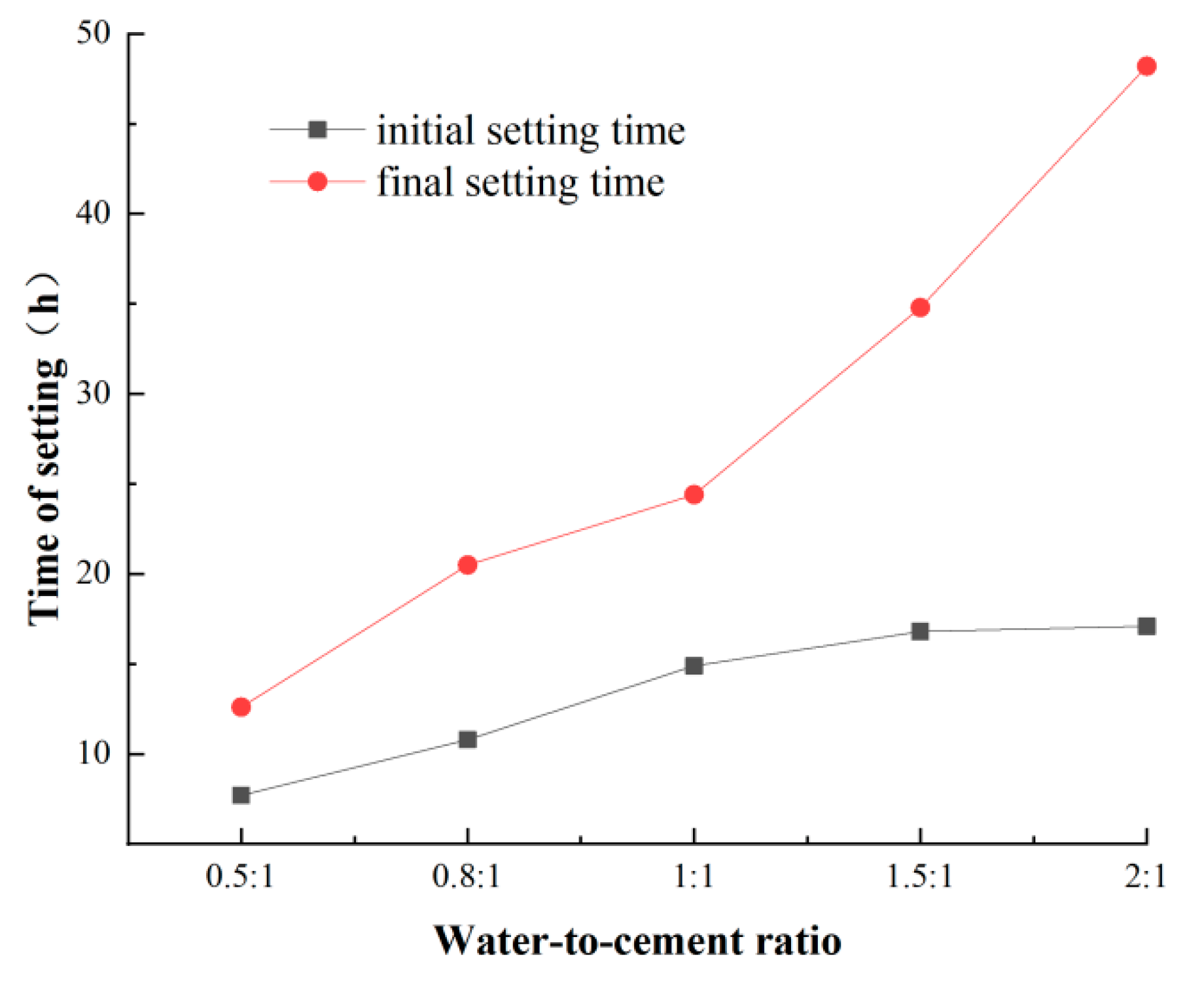
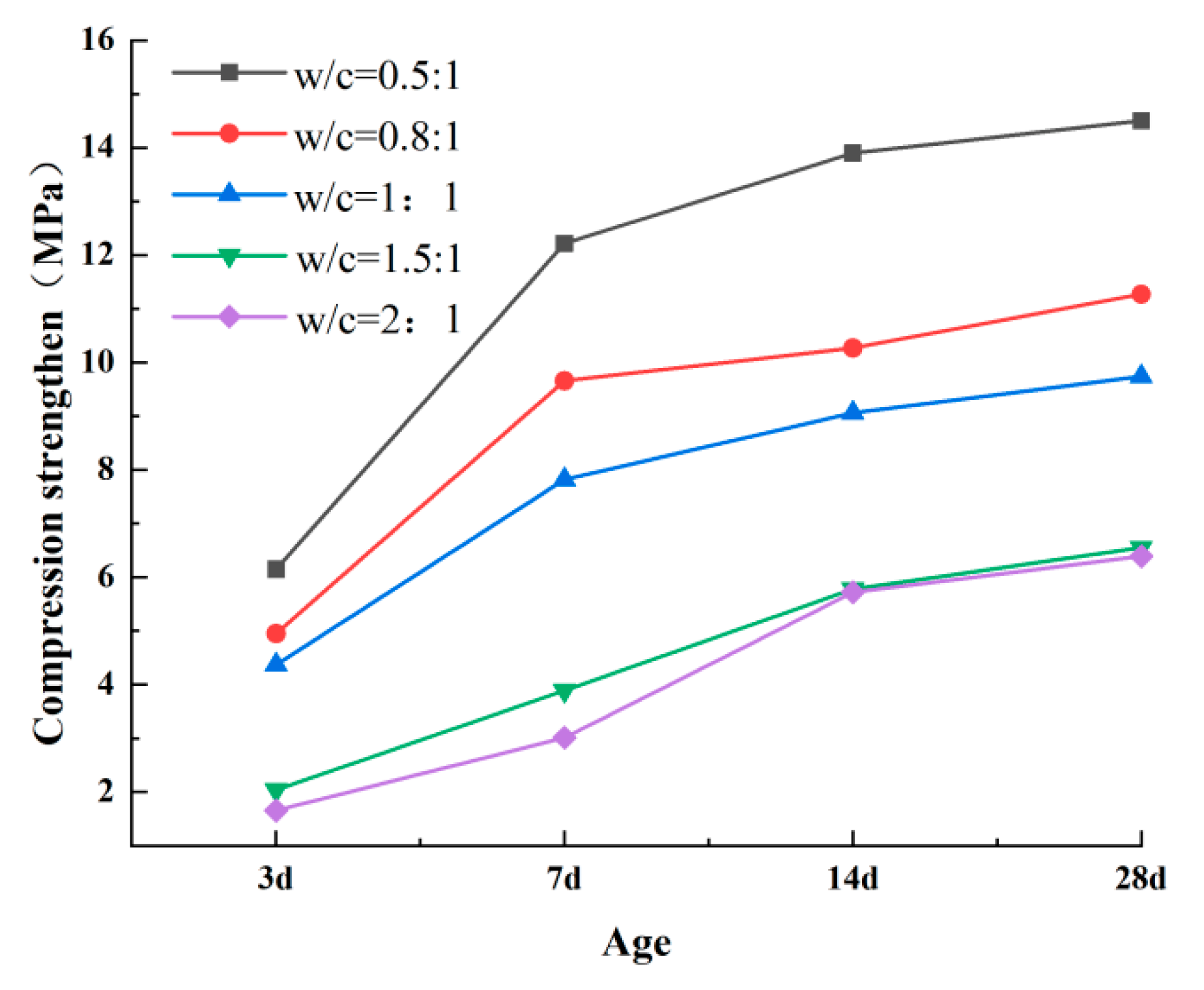
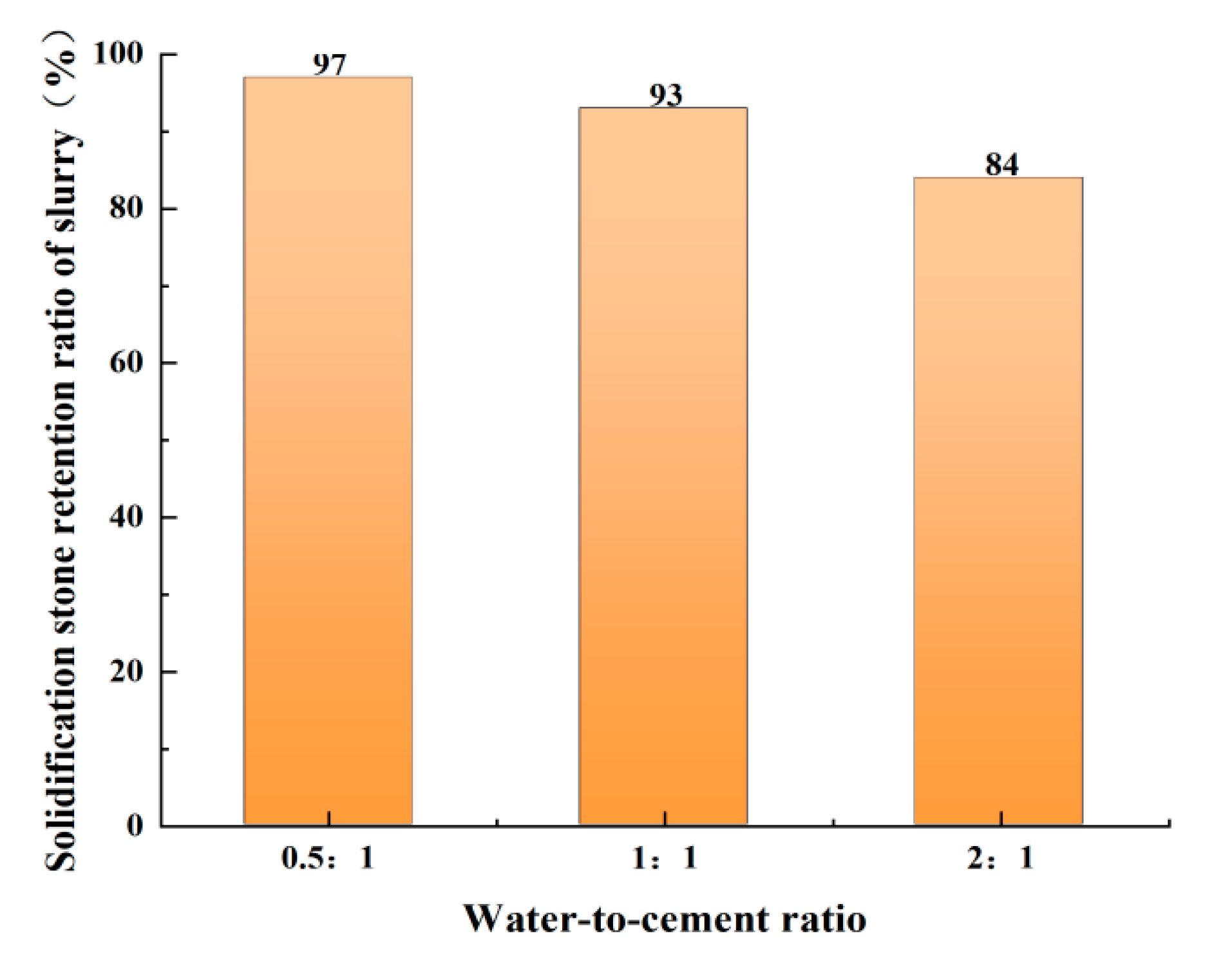
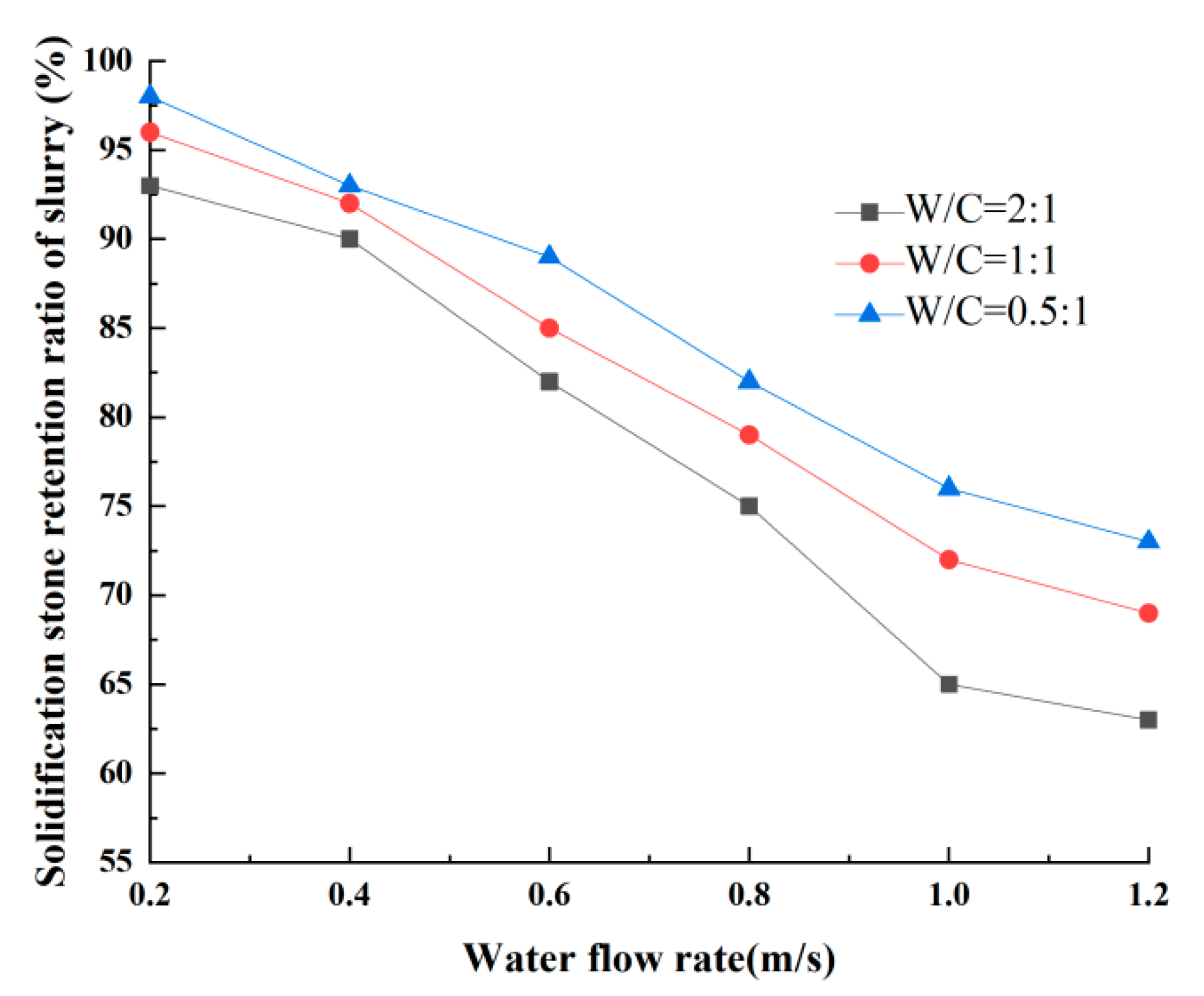

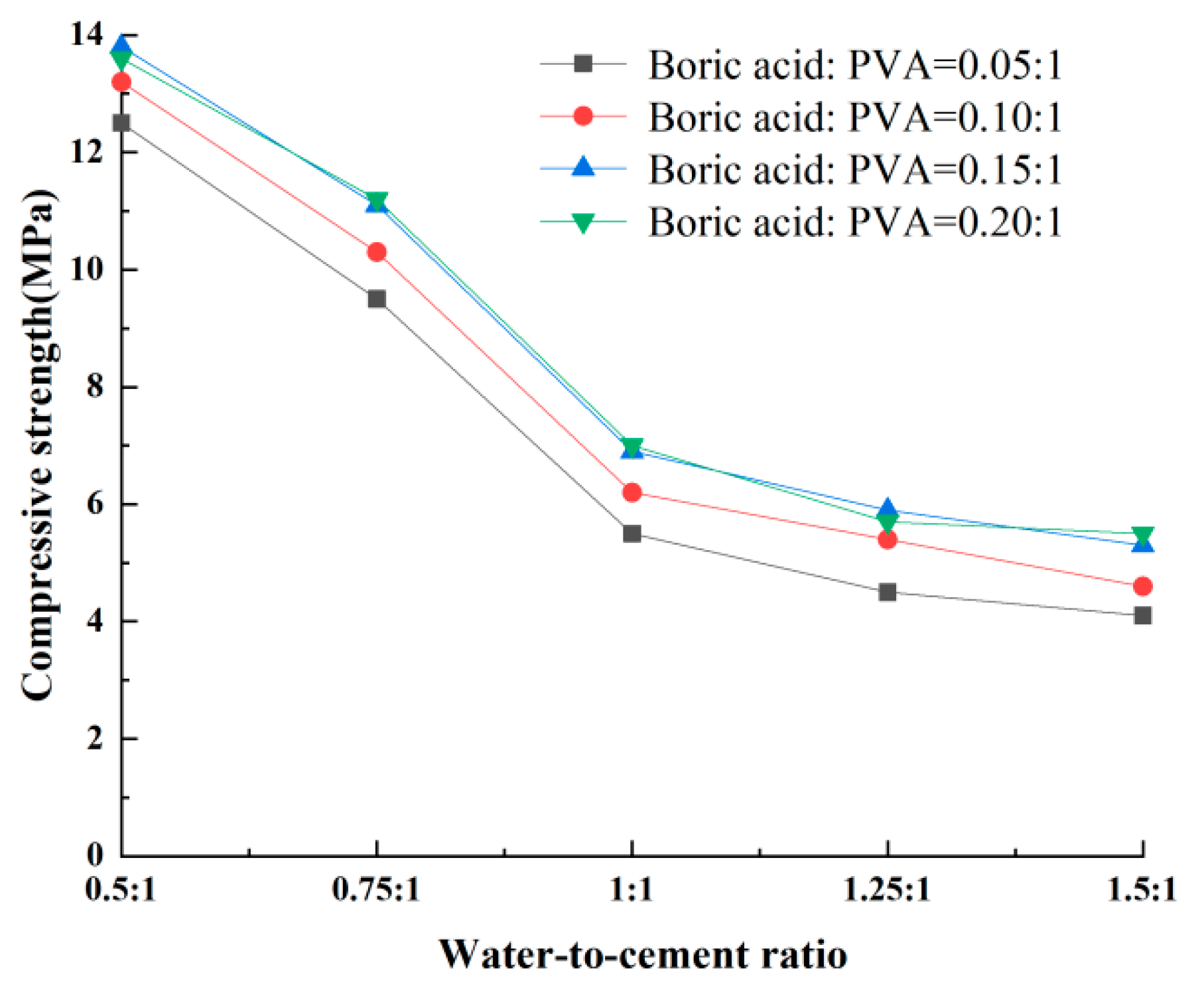

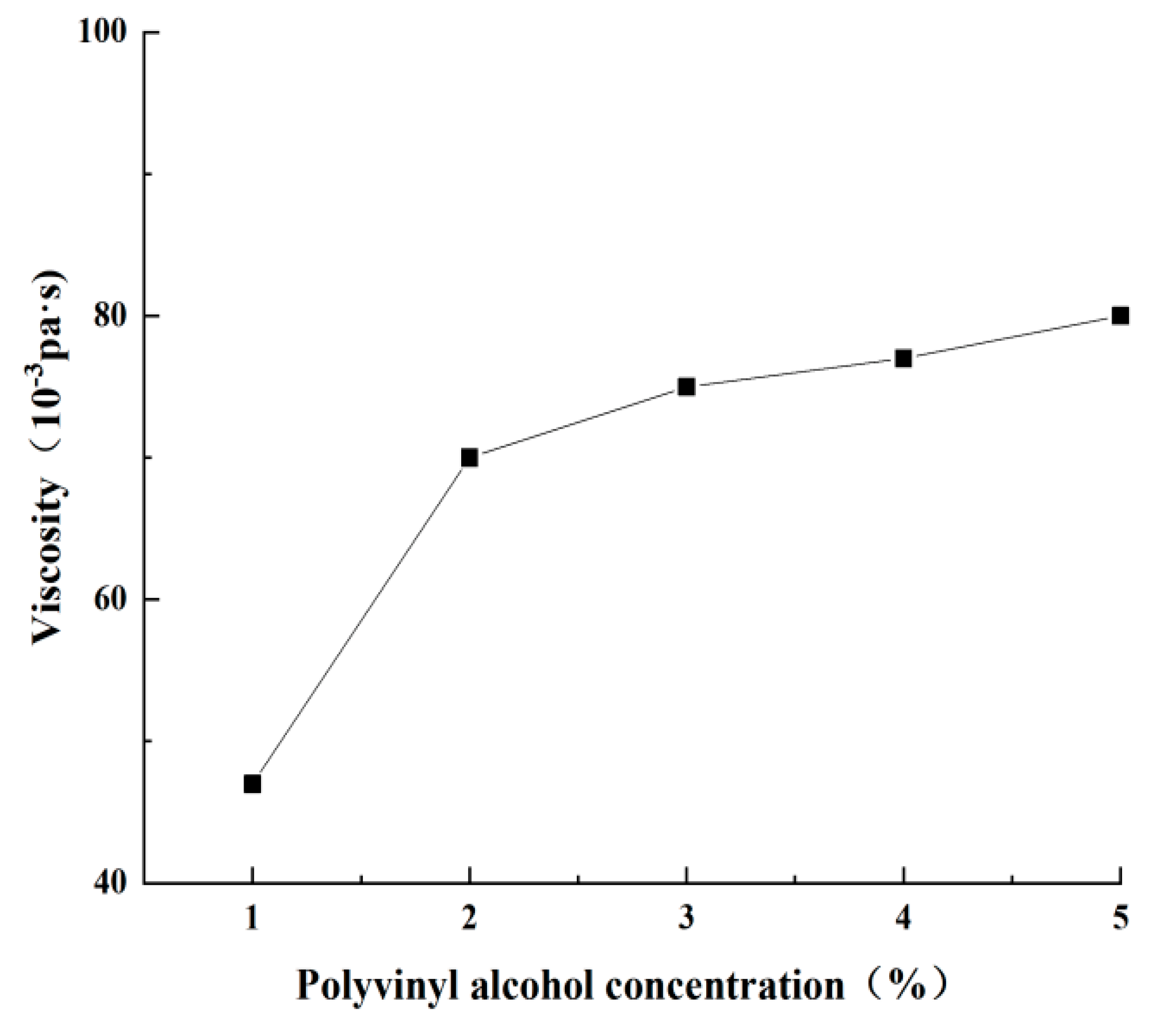
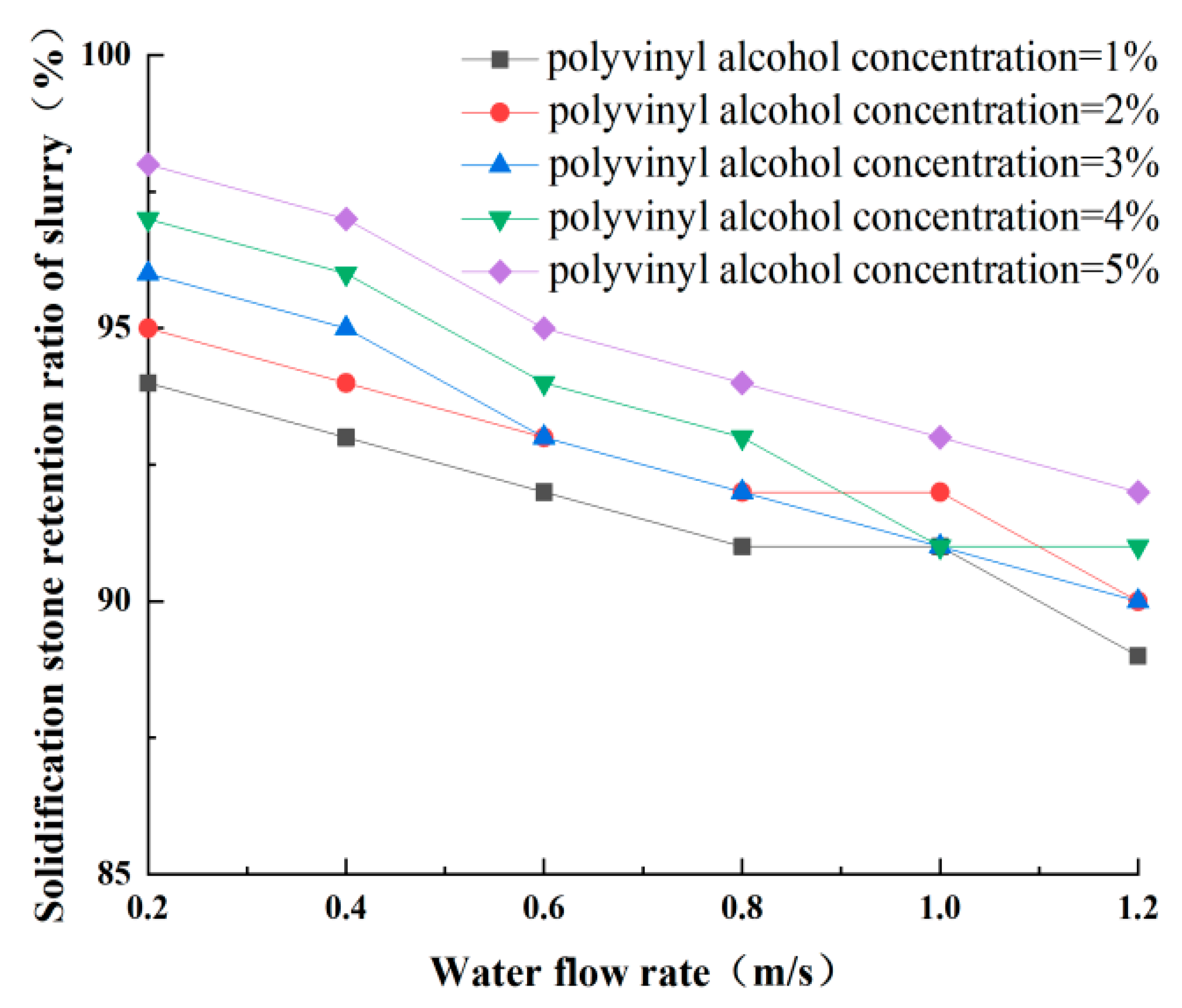

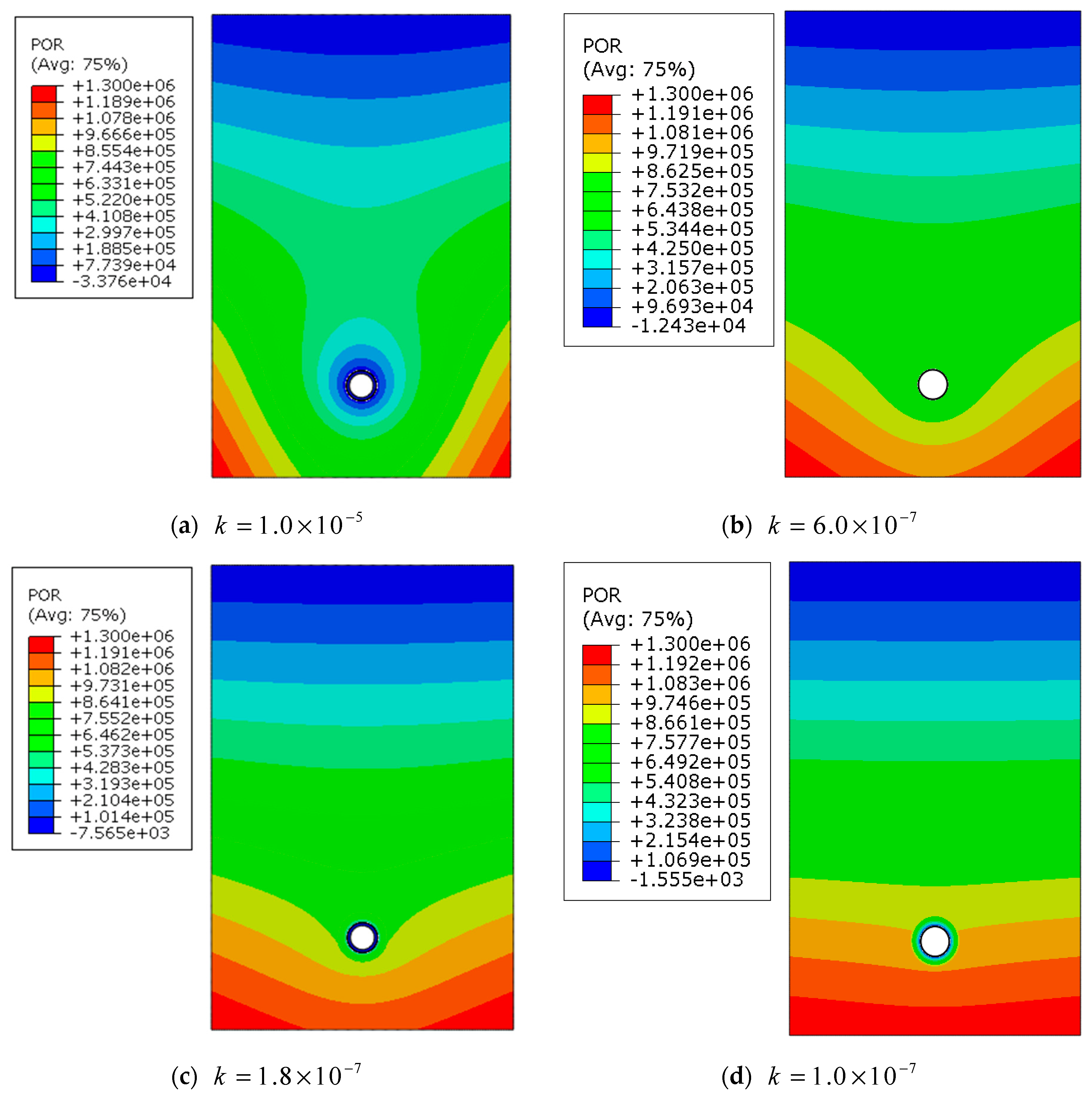
| W/C | 0.5:1 | 0.75:1 | 1:1 | 1.5:1 | |
|---|---|---|---|---|---|
| Concentration | |||||
| 1% | 189 | 654 | 1108 | 1598 | |
| 2% | 174 | 612 | 1097 | 1574 | |
| 3% | 154 | 563 | 1006 | 1528 | |
| 4% | 121 | 487 | 987 | 1503 | |
| 5% | 97 | 425 | 945 | 1458 | |
| No. | Slurry Type | Water–Cement Ratio | Additive Volume Ratio | External Additive Concentration | Age |
|---|---|---|---|---|---|
| A01 | Cement slurry | 1:1 | / | / | 3 d |
| A02 | Cement–polyvinyl alcohol | 1:1 | 4:1 | 5% | 3 d |
| Working Condition | Slurry Type | Slurry Ring Permeability Coefficient (m/s) | Water Pressure Outside the Liner (MPa) |
|---|---|---|---|
| Case 1 | No grouting | 1.0 × 10−5 | 0.78 |
| Case 2 | Cement slurry | 6.0 × 10−7 [37,38] | 0.61 |
| Case 3 | Cement + water glass | 1.8 × 10−7 [39,40] | 0.54 |
| Case 4 | Cement + polyvinyl alcohol + boric acid | 1.0 × 10−7 [41] | 0.42 |
Disclaimer/Publisher’s Note: The statements, opinions and data contained in all publications are solely those of the individual author(s) and contributor(s) and not of MDPI and/or the editor(s). MDPI and/or the editor(s) disclaim responsibility for any injury to people or property resulting from any ideas, methods, instructions or products referred to in the content. |
© 2023 by the authors. Licensee MDPI, Basel, Switzerland. This article is an open access article distributed under the terms and conditions of the Creative Commons Attribution (CC BY) license (https://creativecommons.org/licenses/by/4.0/).
Share and Cite
Yao, J.; Feng, D.; Wang, Z.; Peng, C.; Zhang, Y.; Han, L. Experimental Study on Performance of Modified Cement-Based Building Materials under High-Water-Pressure Surrounding Rock Environment. Coatings 2023, 13, 501. https://doi.org/10.3390/coatings13030501
Yao J, Feng D, Wang Z, Peng C, Zhang Y, Han L. Experimental Study on Performance of Modified Cement-Based Building Materials under High-Water-Pressure Surrounding Rock Environment. Coatings. 2023; 13(3):501. https://doi.org/10.3390/coatings13030501
Chicago/Turabian StyleYao, Jun, Di Feng, Zhikui Wang, Chengcheng Peng, Yonggang Zhang, and Lei Han. 2023. "Experimental Study on Performance of Modified Cement-Based Building Materials under High-Water-Pressure Surrounding Rock Environment" Coatings 13, no. 3: 501. https://doi.org/10.3390/coatings13030501
APA StyleYao, J., Feng, D., Wang, Z., Peng, C., Zhang, Y., & Han, L. (2023). Experimental Study on Performance of Modified Cement-Based Building Materials under High-Water-Pressure Surrounding Rock Environment. Coatings, 13(3), 501. https://doi.org/10.3390/coatings13030501






